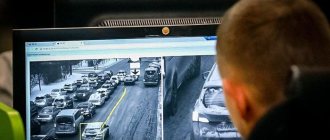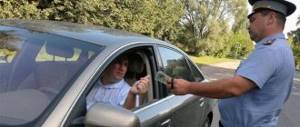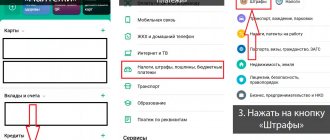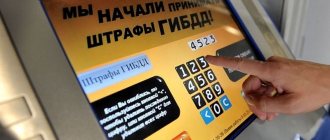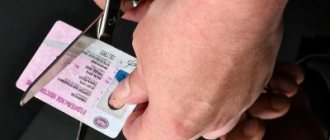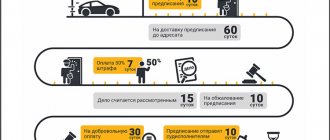Was a fine issued - according to the law or not?
The procedure for recording an offense is the main basis for issuing a fine. And if there was none, but nevertheless, the driver was issued a fine, he has every legal right to ask the question: “Is it legal for it to be imposed on him?” Let's give an example: the road along which a car is traveling is under video recording, but there is no sign indicating this anywhere. By the way, this incident happened in reality. Back in 2014, a car owner living in Tyumen won a court case for an illegal fine, citing the fact that the sign that was supposed to warn him and record video on the road section was not installed. Similar cases occur when a motorist drives into the oncoming lane. In 2007, for such behavior on the road, they were deprived of their license for six months, but since 2013, in addition to deprivation, they have also legalized a fine, which can reach 5,000 thousand rubles. Referring to such innovations, traffic police officers immediately began to pay close attention to such violations, and sometimes cross all boundaries, thereby violating the letter of the law.
Well, for example, the road is covered with snow in winter, and of course, it is impossible to see the markings, there is no sign on the road that would prohibit driving into the oncoming lane, and the driver does this. It is impossible to punish him for this, since the information was not conveyed to him that it was prohibited to drive towards him on this section of the road. And when explaining this fact to a traffic police officer, the driver, unfortunately, almost always remains guilty, since the patrol officers do not want to listen to him and simply issue a fine.
According to statistics, you can often find almost identical cars on the roads. They have the same brand, color and even somewhat similar numbers. And how offensive it becomes to a person when he, who has never violated any traffic rules, receives a fine, but a reckless driver in a similar car remains unpunished. Such situations occur because of those very video recording cameras that do not accurately identify the car and thus, because of them, decent drivers receive fines.
You can also often find that a fine for high speed and behavior violations near a pedestrian crossing is issued without any significant evidence. For example, equipment that records a vehicle speeding does not include photography or video recording. Then, the question immediately arises: “On what basis, where to apply, was a fine issued at all, if it is simply impossible to prove the fact that the road was not given way to the pedestrian?”
Rarely, but there are such road incidents that reach the point of absurdity. Back in 2021, a driver living in Moscow received a fine for driving into the oncoming lane. As it turned out later, after studying the photo attached to the fine, it was not the car itself that drove into oncoming traffic, but its shadow. The driver was so offended by this injustice that he went to court and challenged the issuance of a fine. As a result, the unjustified offense against him was dropped.
- Adhering to the law, the following reasons can be given that may serve to cancel the fine:
- The definition of the offense was incorrect.
- During the preparation of the protocol, certain norms were violated. These include the lack of witnesses, the lack of a certificate for the equipment on the basis of which a fine is issued, as well as obtaining evidence that is illegal.
- The statute of limitations has expired.
- The case of an administrative violation is being considered without the personal presence of the culprit, since he was not notified about it.
Description of the stages that must be completed to appeal the issuance of an illegal fine
Every vehicle owner has the right, established by law, to challenge the imposition of a fine. But, unfortunately, not everyone knows how to do this.
The driver can appeal against the illegal imposition of a fine in the manner prescribed by law, and it includes the following steps:
- An appeal against a fine is possible only within 10 days after the driver receives notification of his offense.
- Article 30 part 2 of the Code of Administrative Offenses gives each owner the right to apply to the authority he chooses:
- Direct appeal to the person who issued the fine. But, as a rule, such an appeal will be sent to a person with a higher position, so the next point is identical to this;
- Appeal to a higher official who is authorized to study these appeals;
- Appeal to judicial institutions (district or city) at the place where the decision was made.
As you can understand, the driver has several methods in his arsenal that will help him establish that he is right - to solve the problem in the traffic police, as they say, in a pre-trial manner, or to appeal a fine issued without legal grounds in the court itself.
IMPORTANT !!! In the event that while a traffic police officer is drawing up a protocol on the violation, the driver has every right to disagree with his arguments. For this reason, the protocol contains a column called “Explanation of the person”, in which the owner of the car can indicate his disagreement with the traffic inspector, for one reason or another. The employee filling out the protocol does not have the right to prohibit a person from filling out this column. It is illegal.
The majority of drivers, as statistics show, flatly refuse to sign the report on the offense drawn up by the road patrol officer. From the legal side, such behavior is illogical, because the inspector has every right to finish drawing up the protocol without the driver’s signature, inviting two people as witnesses. And, as a result, the driver’s categorical refusal to sign the document may turn against him if the case is considered by the court.
Why did the fine remain in the database after payment?
The driver made a mistake in the order number. A driver or bank operator could accidentally pay a fine using incorrect details. Contact your bank to cancel the payment and make a new one. If the payment has already been sent to the traffic police, write there a request for a refund.
The bank did not transmit information about the payment to the GIS GMP. Banks are required to transmit the payment within three days, but there could have been a computer failure or a human error. Ask to unload again. If the bank claims that the data was transferred, contact the traffic police.
If the bank transferred the information to the GIS GMP, then there will no longer be a fine on the verification and payment services. If the fine is displayed, the bank did not transmit the information, or the fine was partially paid.
The bank transferred information about the payment to the GIS GMP without indicating the UIN. This can happen if the payment was accepted by a person and not a computer. Contact the bank with a payment receipt - the error should be corrected.
The traffic police resolution contains incorrect details. If, after three days from the date of inspection and payment, the fine is still listed in the database, contact the traffic police.
There was a failure in the GIS GMP. Check the payment status the next day after paying the fine.
How to file a complaint with the traffic police that an illegal fine was issued
To help a person successfully challenge a fine, first of all, a correctly drafted complaint will help. All requirements that must be included in such a complaint are described in the Civil Code of the Russian Federation, namely in its Article 322.
ATTENTION !!! It is quite understandable that when preparing a complaint, a person is at the mercy of emotions, since he was accused of something that he did not commit. But, do not forget that a complaint is a document, and it is inappropriate to write an opinion about the inspector who compiled the protocol.
The complaint is drawn up in free form, but, nevertheless, if you are going to write it, you should adhere to a certain writing order:
- First, provide information about the person against whom the complaint is being written. Full initials and contact details are required.
- Next, indicate all information about yourself (the applicant), place of registration and contact information.
- Indicate the protocol number and the date on which it was drawn up.
- Write about asking to cancel the resolution.
- State the reasons why additional review of the protocol should occur.
- State the facts that prove that the applicant is right. This may include quite a lot of evidence, but, as a rule, it is video footage, photos, technical documents and more.
- Indicate the request: “Please consider it without my personal presence.” This must be done if the applicant cannot be present, so to speak, during the “showdown” of the case.
- Sign a document.
- Indicate the date on which the complaint is written.
After drawing up a written complaint, you can give it in person to the department, making sure that the employee has made a note of acceptance on it. Or, as an option, a ready-made complaint can be sent to the traffic police using mail services, and indicating that after delivering the letter to the addressee, it is necessary to provide the sender with a notification about this. Well, the last option is to send a complaint via the Internet using the traffic police website.
As mentioned above, the traffic police must consider the complaint within 10 days. This is stated in Article 30.5 of the Administrative Code. If, after the allotted time to study the complaint, the person is refused, he can go to court, which will make the final decision.
What if you haven't received a resolution?
As already mentioned, quite often the mail malfunctions and documents from the court, as well as “chain letters” from the traffic police, can take a very long time or even get lost somewhere.
What then to do if a person did not receive a notice of a fine or a court order? It turns out that then it is impossible to challenge it, but you have to pay twice as much?
How much time is given to pay the fine?
Today there is a very interesting scheme in place with fines.
According to the law, 60 days are given to pay a fine for violating traffic rules from the date the resolution comes into force. Every Russian car enthusiast has another 10 days for it to come into force. Therefore, in fact it turns out to be 70 days. At the same time, you can save money if you make a payment within 2 days from the date of the decision. Indeed, in this case, the driver, according to the Code of Administrative Offenses of the Russian Federation, can pay a fine of half the amount.
At the same time, it is necessary to take into account that the countdown is carried out in calendar days, while banking institutions work only 5 days a week, they have holidays and weekends.
If the decision arrived by mail, the person received it, then within 10 days he has the right to submit an application in which he describes his disagreement and send it to court.
If he agrees, then from the 11th day a 60-day period begins, during which payment will need to be made. Otherwise, for non-payment or late payment of the fine, you can receive a new penalty, and the amount will double.
What if the resolution was not delivered?
If the notice of the decision was sent by mail, but the driver (intentionally or unintentionally, it does not matter) did not receive it, then the letter is sent back to the traffic police.
And after it is received by this executive body, it automatically comes into force.
It turns out that no one cares why the person did not receive the notice; he is obliged to pay a fine. Quite often in judicial practice there are situations when the driver found out that he had fines only after the arrival of the bailiffs, who demanded to pay the debt.
What if the notice is delivered, but the fine is not paid?
Deliberate evasion of payment of sanctions is a serious violation. If the driver does not pay the fine within the specified period, then an additional penalty will be imposed on him, and legal proceedings will also begin.
In advance, bailiffs come to him with a demand to pay the required amount within a certain period of time (usually up to 5 days). If the driver still evades, then after the court’s decision he will have to pay not only his debt, but also legal costs.
Reluctance to pay fines threatens with another unpleasant thing. Like all persistent defaulters, such would-be drivers may be refused permission to travel abroad. If you have accumulated fines of more than 30 thousand rubles, then the court may rule on such a restriction. Fortunately, without a decision, customs officers will not be able to detain you.
What's the solution?
Drivers who are confident that they are right can, of course, sleep peacefully.
However, road surveillance cameras can easily record an erroneous violation, the post office can take a long time to deliver a notice of a fine, and the traffic police will wait for the fine to be paid and impose new penalties for non-payment. There is only one way to protect yourself from this state of affairs - regularly check your debts with the traffic police.
There are several ways to check car claims today:
- request to the traffic police in writing;
- visit to the traffic police in person;
- online service.
The last method is very simple, and today there are several sites where you can check fines. To do this, you need to enter the state number of the car, the number and series of the technical passport, as well as information about the driver’s license into the form.
This approach solves many problems with the delivery of notifications, and situations where the resolution was lost somewhere along the way.
There is, of course, a category of lucky people who received a fine, but the bailiffs never got to them. If within 2 years no one has applied for collection, then the resolution is canceled. There are rare exceptions, but counting on luck is not the best option.
If you received a fine, you can pay it with a 50% discount. To do this, several conditions must be met, one of which is to meet the deadline within 20 days. The second condition is that your violation should not be serious.
A discount on payment is not provided in case of driving while intoxicated, repeated speeding, driving through prohibitory signs, refusal of a medical examination and causing moderate and severe damage in the event of an accident.
Also, the issue of penalties can be resolved with the help of the same court. For large amounts, it is not always possible to pay them off immediately.
Therefore, in order not to create unnecessary problems for yourself, you can go to court and explain your financial situation, providing documentary evidence of your words, and ask for a deferred payment or installment plan. The fine is deferred for 30 calendar days; installments can be issued for a period of 3 months, in equal installments.
Court and illegal fine
Before starting legal proceedings regarding the illegal imposition of a fine, it is necessary to determine which court to go to. The territorial jurisdiction of an institution can be determined using the Justice website. If the fine was issued by the inspectorate, then you should go to the first instance court (district, city or world). But, if the decision was made by the court, then you should go for an appeal to an even higher authority (for example, the regional one). The authority to which the complaint must be filed has been determined and the decision has been sent for consideration. Again, you can file a complaint only within 10 days after the driver has a copy of the decision in his hands. If during this period he does not have it, the driver has the full right to file a petition to renew the appeal period.
The court, unlike the traffic police, can consider a complaint not for 10 days, but for as long as 2 months. This difference in time is explained by the fact that the judicial authority must study all the evidence in detail and come to an objective verdict. But, as in any case, this also has its exceptions. Consideration of the application by the court can last only one day if the person who received the fine is also under arrest.
After examining the case, the court may come to the following decisions:
- The complaint is dismissed and the decision remains unchanged.
- Approve the complaint, remove the fine, and close the case.
- Cancel the fine and redirect the opened case for further consideration. This occurs if, while the court is studying the complaint and accompanying documents, new facts and circumstances arise.
How information about a fine appears in the traffic police database
The owner of the vehicle who committed the violation first receives information about the fine. Next, the documents are transferred for loading into the information system. The following scheme is assumed:
- the data appears in the regional database;
- transit of information to the federal database is carried out;
- information appears in the Federal Treasury.
The latter department records payments in an information system that includes data on state and municipal payments. And only after that open information appears.
How long is data on an administrative offense stored in the Ministry of Internal Affairs database?
According to Part 8 of Art. 32.2 of the Code of Administrative Offenses of the Russian Federation, information is immediately transferred to the Federal Treasury if the payment was made in a terminal, Sberbank mobile banking, online service or from an operator at the bank. There is an answer to the pressing question of how long an administrative offense is stored in the database: it is recorded until it is completely repaid.
The transfer period ranges from 2 days depending on the chosen method. Thus, processing on the State Services website takes several weeks. If payment is not received, storage is carried out for an unlimited time.
Law and abolition of the fine
The court can approve a driver’s complaint that a traffic police officer illegally issued him a fine only if:
- There is no human guilt.
- There are no actions that constitute grounds for a fine. For example, there is no record of a car driving towards you.
- The offense is described incorrectly, and it is replaced with a simple warning, and the fine is removed.
- There are facts that the person has already been prosecuted several times for this violation.
- There are grounds for releasing the person.
- There are no actions by the driver aimed at committing an offense.
- The statute of limitations has expired. Traffic police fines are valid for 2 months, and court fines are valid for 3 months.
Conclusions from history
The post office is required to deliver letters containing administrative orders on time. If the deadline for paying the fine has expired and the driver did not receive the letter due to a mail error, he cannot be punished twice.
The same applies to the validity period of the discount. They can be restored if the post office lost or did not deliver a copy of the resolution.
And it is not necessary to pay a double fine, even if payment of the fine was late.
Need help appealing a fine?
Contact our specialists.
We will promptly consider your question and prepare a complaint against the decision to the court or the traffic police. Appeal the fine
Don't miss new useful publications
We will tell you about the intricacies of the legislation, help you understand it and tell you what to do in controversial situations.
Why do erroneous fines occur?
In recent years, drivers have begun to complain that they are receiving so-called “lucky letters” in the mail, requiring them to pay a fine. And everything seems to be clear and understandable. But, while studying the letter, the driver realizes that this is not his car and he is not the offender, but that there was simply a mistake.
Why this might happen and why "happy letters" often go wrong:
- There is another car that has fake license plates that match the accused driver's license plate.
- The car is listed as stolen, and the person who committed it is violating traffic rules.
- A man sold his car, but information about the new owner has not yet been entered into the database, and therefore letters with fines are sent to the old owner.
- The equipment recording violations counted the license plate number of the accused driver, since she was driving immediately behind the car that had violated the traffic rules.
Such erroneous “happy letters” can also come because traffic police inspectors very often do not carefully draw up the puncture and do not fully understand the situation. Very often, one wrong number or letter can cause an innocent driver to receive fines that are not due to him. Also, in modern times, special equipment helps inspectors in catching offenders. After it detects a violation, all data enters the computer and there it processes it. Only then, all the information is received by the operator, who at a quick glance assesses the correctness of the robot’s actions, and, unfortunately, also sometimes makes mistakes. And because of such inattention, a whole chain arises leading to the appearance of erroneous fines. After all, after studying, the operator transfers the fact of violation into the hands of the inspector himself, who very often does not check all the information, but simply signs. After all, he is sure that the computer and the operator have already checked everything.
Why is the fine not in the database?
Didn't reach the base. It happens that information from the traffic police enters the GIS GMP with a delay. Or regional traffic police departments send a copy of the resolution by mail before adding the fine to the database. Therefore, if there is no fine in the database, first check it again every other day.
The base was unavailable. The GIS GMP database is stored on servers. It is possible that when you checked the fines, maintenance was being carried out on the server. When this happens, on State Services there is a banner at the top of the website: “Services of the Ministry of Internal Affairs of Russia may be unavailable.” Check the fine in a couple of hours or use the alternative service “Traffic Police Fines”.
Invalid STS number. It happens that when checking a fine, a driver makes a mistake in the vehicle registration certificate number. Check the number - most likely you will see a fine from the decree. If the number is correct, it means that the information about the fine did not reach the database, or the database was inaccessible.
Invalid license number. This is also a common mistake when checking a fine. Check your driver's license number and pay the fine.
The fine was issued to a legal entity. If the car belongs to a company, the traffic police almost always issues a fine not to the driver, but to the organization - according to the tax identification number. If you receive a decision about a violation in a company car, check who the fine was issued to.
There was a failure in the database. Computer failures occur on the GIS GMP side. The Federal Treasury recommends checking the fine the next day.
This is a parking fine. Pay attention to the first digits in the resolution number. If the number begins with the numbers 03554310, this is a fine for non-payment of parking in Moscow, issued by the AMPP. If the number starts with 035604, this is a violation of parking rules in the capital, issued by MADI. In other cities, fines are coming from local departments.
If you do not agree with these fines, you have the right to appeal them. The appeal period is 10 days from the date of the decision.
